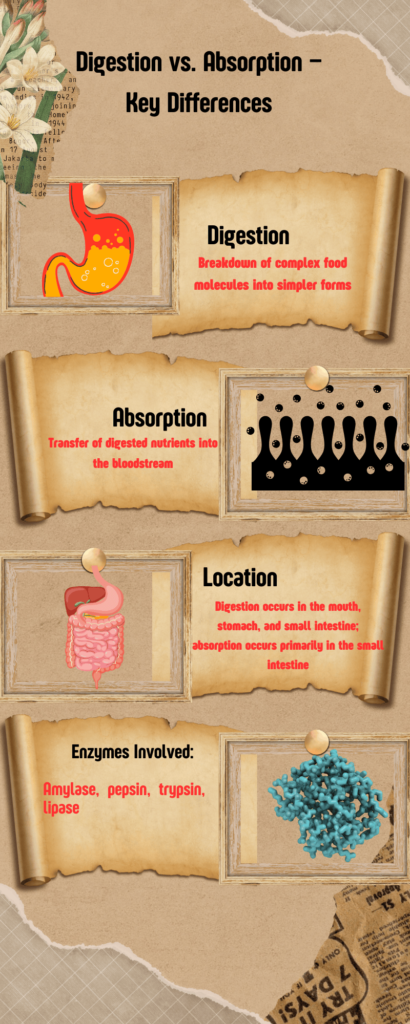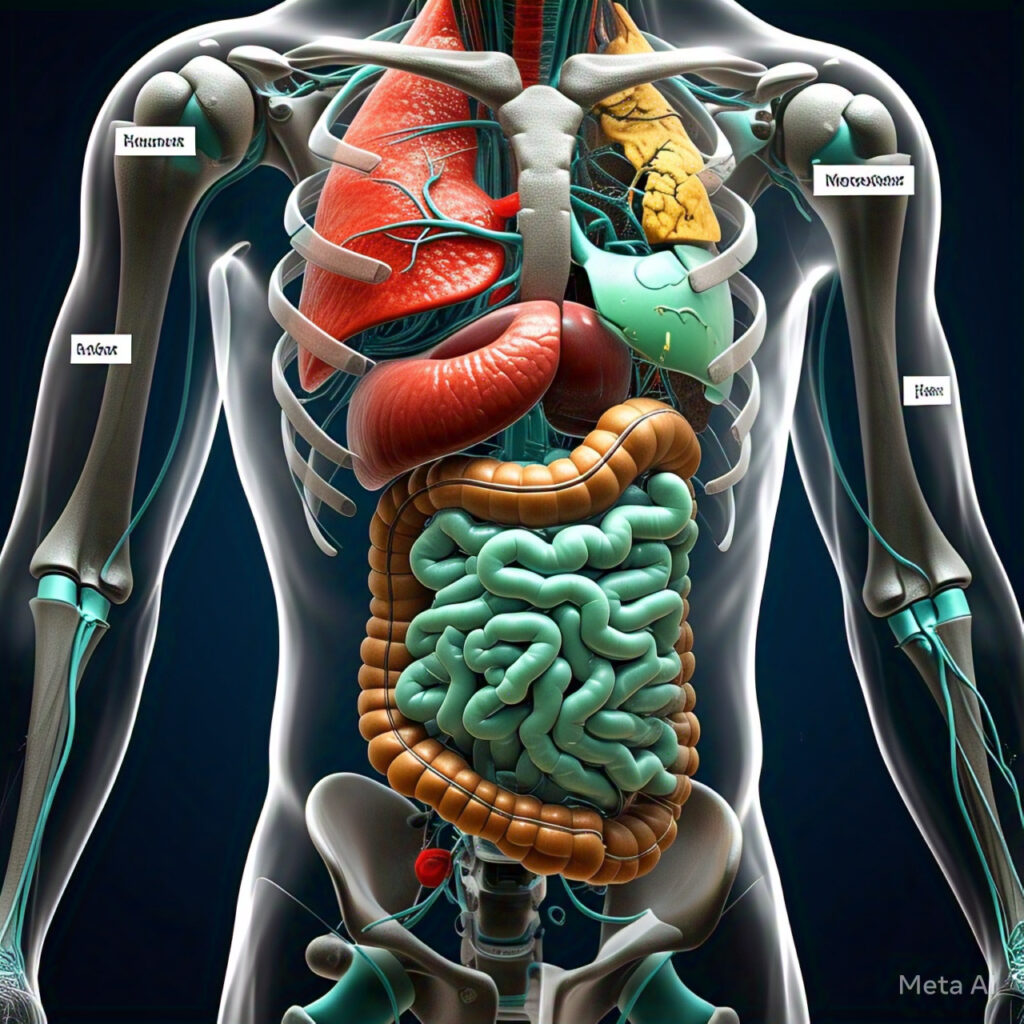Digestion and absorption class 11 are essential biological functions that break down complex food substances into simpler, absorbable nutrients.
These processes play a crucial role in supplying energy, facilitating growth, and maintaining overall health.
For Class 11 students, a thorough understanding of digestion and absorption is fundamental as it serves as a foundation for advanced biological studies.
This article presents an in-depth explanation of digestion and absorption, following the Class 11 NCERT Biology curriculum.
It also explores the roles of the liver, gallbladder, pancreas, and the nervous system in regulating digestion.

Definition of Digestion and Absorption Class 11
Digestion refers to the breakdown of complex food molecules into smaller, soluble substances that the body can absorb.
Absorption is the process through which these digested nutrients enter the bloodstream and are transported to cells for energy and other functions.
Together, digestion and absorption ensure the body receives the necessary nutrients for proper functioning.
Overview of the Human Digestive System
The human digestive system is a highly coordinated network of organs responsible for processing food.
It consists of two main components:
Alimentary Canal: A continuous, muscular tube that includes the mouth, esophagus, stomach, small intestine, large intestine, rectum, and anus.
Accessory Organs: These include the teeth, tongue, salivary glands, liver, gallbladder, and pancreas, which assist in digestion.
Each organ contributes uniquely to the digestion and absorption of food.
Stages of Digestion
Digestion occurs through a sequential process that starts in the mouth and continues throughout the alimentary canal. Below is a detailed breakdown:
Digestion in the Mouth•
Mechanical Digestion: Food is broken down into smaller particles by chewing (mastication), aided by the tongue.
Chemical Digestion: The salivary glands secrete salivary amylase (ptyalin), an enzyme that begins the breakdown of carbohydrates into simpler sugars like maltose.
Digestion in the Stomach
The stomach, a muscular J-shaped organ, temporarily stores and churns food.
Gastric glands secrete gastric juice containing:
Hydrochloric acid (HCl): Provides an acidic environment to kill bacteria and activate enzymes.
Pepsinogen: Converts into pepsin, which breaks down proteins into peptides.
Mucus: Protects the stomach lining from acidic damage.
Digestion in Small Intestine
The small intestine, comprising the duodenum, jejunum, and ileum, is the main site of digestion and absorption.
Key digestive substances involved include:
Pancreatic Juice: Released by the pancreas, it contains enzymes like trypsin (for proteins), lipase (for fats), and amylase (for carbohydrates).
Bile: Produced by the liver and stored in the gallbladder, it aids in fat emulsification, breaking fats into smaller droplets.
The small intestine also secretes enzymes such as maltase, lactase, and sucrase, which further break down nutrients into simpler forms.
Functions of the Liver, Gallbladder, and Pancreas
These accessory organs play essential roles in digestion:
Liver:
Produces bile, which facilitates fat digestion.
Detoxifies harmful substances and processes absorbed nutrients.
Gallbladder:
Stores and concentrates bile.
Releases bile into the small intestine when fatty food is consumed.
Pancreas:
Secretes pancreatic juice containing digestive enzymes.
Produces insulin and glucagon, which regulate blood sugar levels.
Nervous System Regulation of Digestion
The digestive process is controlled by both neural and hormonal mechanisms:
Enteric Nervous System (ENS):
Also known as the “second brain,” the ENS regulates gastrointestinal motility and secretions independently.
Autonomic Nervous System (ANS):
The parasympathetic system enhances digestion by stimulating enzyme secretion and intestinal movement.
The sympathetic system inhibits digestion during stress.
Hormonal Regulation:• Hormones such as gastrin, secretin, and cholecystokinin (CCK) regulate the secretion of digestive fluids and the movement of food.
Process of Nutrient Absorption
Absorption predominantly occurs in the small intestine, which is specialized for this function.
Its inner lining is covered with villi and microvilli, which increase the surface area for effective absorption.
Carbohydrate Absorption
Carbohydrates are converted into monosaccharides (glucose, fructose, galactose).
These sugars enter the bloodstream via the villi and are transported to cells for energy production.
Protein Absorption
Proteins are broken down into amino acids, which are absorbed into the bloodstream for tissue repair and enzyme synthesis.
Fat Absorption
Fats are digested into fatty acids and glycerol.
These molecules enter the lacteals (lymphatic vessels) and are later transported to the bloodstream.
Absorption of Vitamins and Minerals
Water-soluble vitamins (B and C) are directly absorbed into the bloodstream.
Fat-soluble vitamins (A, D, E, K) are absorbed with fats.
Essential minerals like sodium, potassium, and calcium are absorbed through various transport mechanisms.

Functions of the Large Intestine
After nutrient absorption, undigested food enters the large intestine, where:
Water and electrolytes are reabsorbed.
Gut bacteria ferment undigested carbohydrates, producing gases and beneficial short-chain fatty acids.
Waste material is stored in the rectum and eliminated through defecation.
Common Digestive Disorders
Several disorders can disrupt digestion and absorption, including:
Indigestion: Caused by overeating, spicy food, or stress, leading to abdominal discomfort.
Constipation: Difficulty in passing stools due to insufficient fiber or water intake.
Diarrhea: Frequent, watery stools caused by infections or food intolerances.
Ulcers: Stomach lining sores caused by excessive acid production or Helicobacter pylori infection.
Jaundice: A liver condition causing yellowing of the skin due to impaired bile secretion.
Tips for a Healthy Digestive System
Consume a Balanced Diet: Include fiber-rich foods, fruits, and vegetables.
Stay Hydrated: Drinking enough water supports digestion and prevents constipation.
Exercise Regularly: Physical activity promotes healthy bowel movements.
Eat Smaller Meals: Avoid overeating to prevent indigestion.
Reduce Processed Foods: Limit sugary, fatty, and highly processed foods.
Conclusion
Digestion and absorption are complex yet vital processes that ensure the body receives essential nutrients.
A clear understanding of these mechanisms is crucial for Class 11 students, both for academic success and a deeper appreciation of human physiology.
Maintaining a healthy lifestyle and recognizing digestive disorders can help promote optimal digestive health.
This article, structured according to the Class 11 NCERT Biology textbook, provides a comprehensive insight into digestion and absorption, along with the roles of the liver, gallbladder, pancreas, and nervous system regulation.
Whether preparing for exams or simply exploring human biology, this guide offers the necessary knowledge to master the subject.
Want to speed up your NEET biology revision?
Visit or shop now!
Frequently Asked Questions ( FAQs):
What is the difference between digestion and absorption?
Digestion is the process of breaking down complex food molecules into simpler substances using mechanical and chemical methods. Absorption is the uptake of these digested nutrients into the bloodstream or lymphatic system for distribution to body cells.
What are the main organs involved in digestion?
The alimentary canal (mouth, esophagus, stomach, small intestine, large intestine, rectum, and anus) and accessory organs (salivary glands, liver, gallbladder, pancreas) work together to ensure efficient digestion and absorption.
How does the small intestine help in nutrient absorption?
The small intestine has villi and microvilli, which increase the surface area for maximum nutrient absorption. It absorbs carbohydrates, proteins, fats, vitamins, and minerals into the bloodstream or lymphatic system
What is the role of bile in digestion?
Bile, produced by the liver and stored in the gallbladder, helps break down fats into smaller droplets (emulsification) to aid enzyme action and improve fat digestion.
How can we maintain a healthy digestive system?
A fiber-rich diet, proper hydration, regular exercise, controlled portion sizes, and reduced intake of processed foods help maintain good digestion and prevent common digestive disorders.
